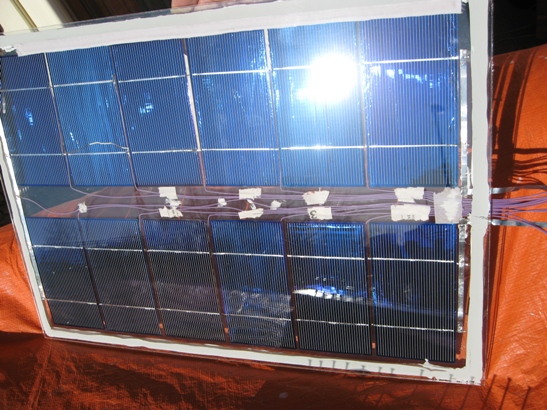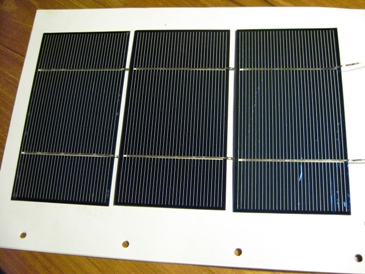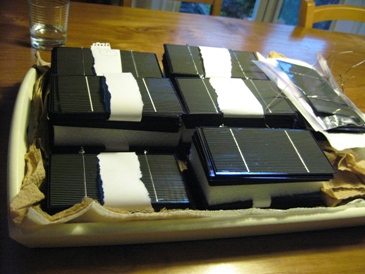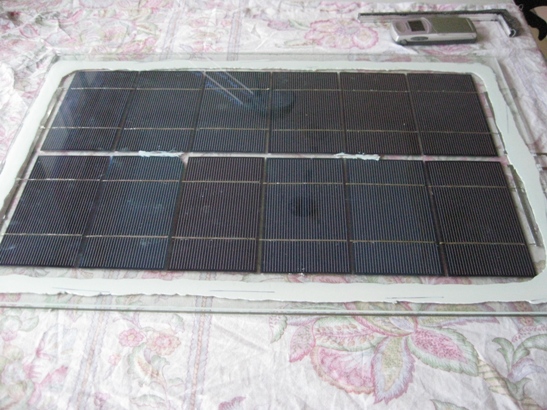 Because I think that the price of a solar panel is still pretty high(in Europe), and because the stimulation from our government (in the Netherlands) is not so good (very,very complicated and time consuming) I started the project of building my own solar panel. I would like to invite anyone who has some experience with this or is interested in it ,to give me any advice or remarks about it. The main challenge is to build a panel that can withstand heat, cold, rain and hail for many years.
Because I think that the price of a solar panel is still pretty high(in Europe), and because the stimulation from our government (in the Netherlands) is not so good (very,very complicated and time consuming) I started the project of building my own solar panel. I would like to invite anyone who has some experience with this or is interested in it ,to give me any advice or remarks about it. The main challenge is to build a panel that can withstand heat, cold, rain and hail for many years.
Buying My First Solar Cells
In October 2008 I bought my first 100 cells via Ebay. But as I later learned, they were still very expensive: 300 Euros for 100 cells, including shipping. I was told they should produce 1,98 Watt each. Below a picture :
After some experimenting and very long brainstorming about how to continue, I found another seller on Ebay who had the same cells (of which he gave the specification that they were 1,75 Wp each……) But these were slightly damaged. Well I decided to buy 500 cells ,a mix of 3 different qualities. The seller had not counted these cells but there were 620 cells, of which after a first selection , just over 500 were reasonably good. Not a bad deal to start with. And a lot cheaper! Also now I had over 100 cells for practice on soldering and handling.
Building the First Small Panel.
Well I got started. Beginning with the soldering-technique, that takes some practice, but after a while you get the hang of it. And now my first small experimental panel is ready! The main focus and moreover challenge is to get the cells 100% sealed: air and water tight. The cheapest solution for me is to make a double-glass construction. And the cells in between the 2 plates of glass. The panel is made of 12 cells, each 0.55 Volts. On the picture below you can see many purple coloured wires. Those wires are each connected in between each cell so afterwards I can still do some measurements to compare each separate cell.

My First Do-it-yourself Solar Panel
The First Measurements in the Sun
I must say that at first I was worried whether I would see the cells really produce the power they should. But after building a variable resistance (making it possible for me to roughly find the maximum power point) the sun at last was shining (not much sunshine here beginning of February) and I got my first real measurement : 15,5 Watt. According to the specifications the panel should give a maximum of 12 x 1,75 W = 21 Wp. Given the fact that the glass takes away about 10% of the power,without the glass it would have been about 17 Watt. I expect that during summer as the sun rises much higher above the horizon, the measurement will give higher readings , thus coming closer to the specifications…. I am using normal 4 mm (0.16 inch) glass because it costs me nothing. If you just look around near places were they renovate old houses you can get the old glass for free…… This compared to the real stuff they use for solarpanels which is quite expensive and probably very difficult to find.
Influence of Heating the Panel in the Sun.
During the first measurements, I found that the heating up of the panel was pretty strong. But this especially was the case for the backside. were the cells are glued upon (using the same kit I used for glueing and sealing the panel). This panel is 12 mm (0.47 inch) thick : 2 plates of glass each 4 mm (0.16 inch) and 4 mm in between. What troubles me is the temperature-difference between the front and backplate of glass. This will result in different expansions creating stress on the sealing,if that is repeated too often it will start leaking. Now I am using the same kit as is being used in solar panel factories. But it still worries me. A solution can be to keep the panels small, so the difference in expansion stays minimal.
Improvements
A solution to the temperature-problem can also be to make the gap between the 2 plates of glass smaller. So the heat will be more evenly dissipated to both the front and backside ( thereby also creating more cooling capacity). My next panel (picture below) is the same size,the difference is the distance between the 2 plates of glass : it is now 1.5 mm (0.059 inch) …..and this also makes the sealing a lot easier and thereby better. I have used pieces of copper winding wire that I happened to have : 1.2 mm (0.047 inch) thick. I took several pieces of about 3 cm and spread them evenly along the side on the glass backplate. Then the kit along them all around the full edge. And finally pressed the front plate on it. The result is a gap between the plates somewhere between 1.2 mm and 1.5 mm. So on the inside, there is some trapped air (with, of course, a certain amount of humidity in it), which can potentially cause condensation. But my hope is that the amount of that is so small (only very small amount of air……) that it will not be a factor…… ( In the first panel I did put some stuff that can “eat” the condensation. I got this out of old double glass that I separated,the stuff is inside the aluminium strips between the double glass edges)
The kit will have to dry for a few days, but anyhow the weather forecast does not indicate any sunshine the coming days………
First Results
Bottom line is that if the output of each cell really hits 1,75 Wp then I can come to a price of Euro 1,20 per Wp (or even lower than that….) And with such a price the panel will not have to last for 20 years……..but off course that is my aim ! That will be the main challenge ! But I must say with this second panel my hopes are getting higher.
You can find more (and more up to date) information on my website
Well, who feels like building panels also ? Or give me some advice, or share experience. I do not mind getting negative critics because they might be correct………and they are there to be solved !
Next Phase
Update: 15 februari 2010:
The first systeem of 400Wp is now fully functional and produced it’s first electricity. The cost price is now around $1.68 per Wp and is expected to drop to $1.10. More information about the next phase in the project can be read in the article DIY Built Solarpanel Installation Now Operational.








171 replies on “Building my own Solar Panel”
I am very impressed at the efficiencies your experiments have acheived. An idea to avoide the condensation concern would be to use an encapsulant this will eliminate the air space. Also be very cautious of the glass you are using as there are all types of spectrum inhibitors wich will reduce your efficiency. The less opacity the better obviously. Also take into account the effects curing the encapsulant, any voids in the material will reduce efficiency. you could try it in a manner similar to how transducers are mounted in boats with epoxy resins (the type that transmit through the hull). Another consideration is the thickness of the glass, the stuff you are using is very fragile, an encapsulant will add to the module’s strength as well as reduce current leakage giving you the most bang for your buck.
There are very few DIY solar websites on the internet that aren’t trying to rip you off. The author of this article along with a couple people who replied are some of the few who actually have websites worth looking at. Why pay for the DIY solar guides when you have people like this who go out of their way to give you solid information for free on their personal websites. I posted all the DIY solar websites worth looking at in the DIY section on http://www.solarpaneltalk.com I’m hoping it will be of some help to those of you tackling this type of project.
I have made 4 solar panels so far but I seal my back different then you. I use sylgard 184 from dupont. It’s a liquid that hardens to seal all the air out of the panel. It also gives with the heat and the expantion of the cells. I have been working with 4×4’s cells and now 6×6’s cells.
I want to make a 72 cell panel next.
Hi Solar Panel,
Thank you for your comment. I have looked at solartalk. I allways wonder why people don’t understand that its more like a hobby. Instead they start calculating the time lost in making the panels, time they could have used to make more money doing other things. Its just a lot off fun building them. And I do have the time to do it.And ofcourse , its a big challenge !
At the moment I am finishing building 8 panels of 50Wp totalling 400 Wp. I want to have that finished before december to let them outside in our wintery environment and see how they last.
Hello Solar/Winds :
Could you tell me how much it has cost you to use the Sylgard per panel (better : per Wp)
The price of my 50 Wp-panel will be about $ 90 ( E 60 )
I have found a place that sell’s sylgard foe $36.87 a peace but they want you to buy at least $100.00 worth .
http://www.Superioressex.com go to shop on line and enter ( DC-184-ms 1.1) This is better then ebay. I needed that much any way. It comes out to three of them.
Hi Chris thanks for the reply. How old is the first panel you made? Have you seen any decrease in production since then?
I agree with what you say. On the forum we stress that exact thing.
I just finished sending an email to you a couple of minutes ago before looking at your last comment. I didn’t know it was you until I put my mouse cursor over your name and saw that your doctersnuggles 🙂
Thanks for taking the time to put out quality information on your website. It’s a great read!
I’ll be checking back on your site to check out the 8 panels when they are completed.
See you around!
Jason
Hello Jason,
I have to disappoint you : I dont have any panels outside yet ! I have to finish a total of 8 panels and connect them in series to get enough power for the inverter that I am going to use. It means 196 cells in series giving 105 Volt unloaded. My inverter has a minimum input voltage of 75 volts. So once the inverter starts working the voltage of 105 volts will drop to around 85 volts , and that’s still above the minimum input-voltage.
Just now I finished panel nr.6 , putting the sealant all around the aluminium frame. It will have to dry for a few days. Panel nr.7 : I need to make the frame first. for panel nr.8 I still need to make most of the parts. So maybe 3 weeks from now nr.7 + 8 will be finished.And then I will have to attach all 8 of them to my house…… I have calculated these panels to be around 50 Wp, meaning I will have an installation of 400 Wp.
These are very low efficiency cells, but I got them so cheap ( about $0.73 or E0,49 per Wp ) that it is worth making these panels. I have calculated the completed panel of 50Wp to cost about $ 90 or E 60. So $1,80 or E1,20 per Wp
The inverter is secondhand. And I bought it for about $0,24 or E0,16 per watt.The only other cost will be installing materials. I guess that it will be around $0,38 or E0,25 per Wp.
If I add this all up I get a complete solarpanel installation for $2,40 (E 1,60……)per Wp !!
The only thing is that it will have to prove itself coming years !
Hi Solar/winds
Once again I ask you : how much sylgard ( in dollars or euro’s ) do you need for a panel ? And how much Wp is that panel ?
11/14/09
I have the three panels out side now and it’s been about three month now. They seem to be holding up to the weather real good . We have had snow and very cold weather so far. I want to power al my Christmas lights this year.
I haven’t cept track of what it cost but I would say I have spent over 2 to 3 thousand dollars so far. I still have three more to go of different size cells. I want to do a 72 cell panel also. I have just received some 6×6 cells and there is about 5 to 6 cells that are no good now . They must of broke in the mail. I need to put my panels in searies .I’m ordering a new Charge Controler , a larger one .I have a 30 Amp now and I’m going to a 60Amp MPPT.
This is just a hobbie for me also. Just having fun.
Chris Van der Zwaal,
I don’t know how to change dollars into euro’s sorry,
I know ourn money is less then Euro’s .Like $1.00 would be 1.75 Euro’s . I’m just guessing. Sylgard is $ 36.87 usa so It’s alittle more exspensive there. Don’t buy Sylgard off Ebay it’s to exspensive there.
I just use one 20oz sylgard to cover a 36 cell panel. I’m making a 6×6 now and I think I might have to use alittle more so I’ll probly use two of them. I have 6 hihg and 6 wide.
Hi Solar/Winds,
I have done some calculations with the figures you have given me. I see that 20 oz is about a pound which is about 0.5 Kg. Now I see that Sylgard is on ebay : 0.5Kg for $53. So you probably mean that you buy this same packing of Sylgard for $36,87. So I conclude that you use that full pot of Sylgard for a 36 cel panel . Is this correct ?
If so , then it is pretty expensive per Wp. Perhaps you can try using it in a thinner layer…..
36 cells of 6×6 inches will be a panel of about 120 Wp . Meaning you use $0,25 to $0,30 per Wp….if you use only one pot of 20 oz.
Yes I use the hole 20 oz’s , 0.5kg to put on the cell’s 36 cells
It’s the only thing I can find right now to seal the back side of the panel. It’s exspensive but it does the work. it’s made for the solar opanels. I’ll probly mix two for the 6×6 becaust it’s a big fraime .I had to buy 3 sylgerds for one order. I think it came out $102 or 5 US $. I am looking into some other stuff but it’s made by Dupont. If i qulify they will send me some samples of three different types and at 20 oz. each. I don’t think I could use a thinner on it becaous once you mix it it takes 5 min. to mix then you have to use it. I don’t know but maybe it would react different if it was thinner. You can buy sylgard in a different type that does not harden fast .It’s just for fun doing this.
Hello,
Anyone out here who has some experience with thin film solar and could give me some pointers ? see panels in cost range of 175 euro with specs like this: Model: SCG55-HV-F
Belangrijkste eigenschappen:
* Open circuit voltage Voc(V): 50,9
* Optimum operating voltage Vm (V): 38,8
* Short circuit current Isc (A): 1,69
* Current at Pmax Imp(A): 1,42
* Maximum power Pmax (Wp): 55
* Power tolerance: ±5%
* Maximum system voltage: 1000V
* Afmetingen: 1258 X 658 X 30 (mm)
* IEC en TUV gecertificeerd
* Gewicht: 14,6 kg
Thnx
Johan
I started another website : http://www.doctersnuggles2.come2me.nl
So far I put only pictures on it ; text will follow…..
Hey Chris, added that site in the DIY solar discussion forum on Solar Panel Talk as well. Thanks for the great pics.
[…] Besides from all this, there is the economical incentive: solar panels are much cheaper than many other forms of energy, such as fossil fuels. Some might argue that this is not true, because purchasing solar panels is so expensive, but remember that it is a one-time investment, which then will provide energy for a long time (figures range from decades to over a century). And it’s becoming cheaper by the minute. It also depends on how you construct and install it – doing it yourself, which isn’t as complicated as it sounds, could save you a lot of money. Here is how Chris van der Zwaal from the Netherlands did it. […]
Good advice here! Glass for both sides allows good sealing and no bother with painting. I have ordered 36 of the new 6 by 6 inch poly cells rated at 8 amps. This should be a 160 watt panel, if all goes well. For my glass I have an excellent source.. A used building materials store nearby. Double-pane windows of tempered glass, various sizes for 15 to 30 dollars. This will be my first try at a panel. I have already good electrical skills.
Amazing to me that people are comparing these home made panels to manufactured panels. The idea is to be resourceful and imaginative. Any warranty on a solar panel increases the cost tremendously. Manufacturers have to factor in a certain percentage of returns in order to turn a profit. Therefore the initial price goes up. When you get a warranty you are paying for it – believe me. I think DIYers like Chris and others will eventually bring the price of solar down. Right now it’s a rich person’s hobby. Not many folks have a spare $40,000 to buy a name brand PV system.
Now, on to the panels. I like what Chris has done. He asked for ideas… one way to evacuate the water vapor would be to leave a small silicone pipe or two protruding into the space and let the water vapor evaporate out with the heat of the sun, then plug those pipes with silicone. If you ever have a condensation problem in the future you could reopen and repeat. Love what you have done and will use your page as a guide while building my 8 ~190 watt panels in Nepal.
I had a friend who wanted to install solar on his roof. I gave him a commercial quotation but he found it too expensive. He ventured in making his own solar modules, pretty much like what Chris did with the cells, glass, soldering, etc. The solar modules worked, but only for two weeks due to corrosion on the wires. His investment worth $14,000 for PV just became room dividers for his house. He eventually get a deal with Shell solar modules that the oil company want’s to get rid off their inventory.
I will make my solar modules just for the fun of it and for the learning process. This is an expensive lesson to learn, but I am not expecting to save on the overall cost of solar modules compared to the commercial ones.
Hello Silver Solar
Pity that your friend did not find a way to build his panels airtight/watertight. Over here in the Netherlands there are a few people allready who have their panel out for over half a year and still running…….
My installation started working jan 1 2010. Worst season to start because we have very little sunshine in januari here in the Netherlands. But luckily jan 1 was a sunny day and it works well. Only thing is that the sun on jan 1 does not come higher on the horizon than 15 degrees……I am expecting the maximum/peak output to happen somewere in april.(low temperatures and sun high enough) Max. production per day will probably be later on when the daylight period will be longer.
Just go and see my second website : http://www.doctersnuggles2.come2me.nl
Hi Chris I like what your doing with charing info.I have perchast two traning systoms and they arnt as good as your websits.I have built to propeler type wind generators.Ied like to see moore of the one you built.I have alot of trees that make turbulans.I think yours would be moore afactive in inconsistant winds.I am working on my 4th solar panel and notice how you bend your tab wire did you make a tool to bend it? it looks so presice and consistant.
I use a pice of lamnated wood flooring to build my string on with pens much like yours.Than I lay anther pice of wood flooring on top to turn tham over after removing the pens.I was floping tham over and brok some so I found anather way.The wood flooring is very slik so it is ezsy to slid tham off in place very little strees.
Hello Chris,
congrats on your full system installation. Your work was and still is inspiring for me. See my website as well:
http://www.xs4all.nl/~hante/index-en.html
regards
Hello Vern,
I use a piece of flat iron-plate that is pretty thin. Then I used my ironsaw to make a cut in it. Then in that cut I place the wire (still perpendicular to the iron) And then I bend the wire to get the bend. It is a bit difficult to explain in words without a picture. I hope you understand how I do it.
Also your idea to turn over the string of cells is a good and simple one. I have heard this idea. But sofar I have been too lazy to change my way of working. Also because I only have 6 cells in a string , and those cells are relatively thick and thus they are relatively strong. For longer strings and weaker cells , your suggestion is much much better and I think even nescesary.
Regards ,
Chris
I do also very much recommend Hante’s website ! If you look for good information go there !
http://www.xs4all.nl/~hante/index-en.html
Chris
Experimenting with RSS. I can keep current with your website from now on- very neat feature
Great article. Developing organic solar cells from polymers, however, is a cheap and potentially simpler alternative
It is astonishing to me just how many individuals are unmindful of the energy concerns that we face. Its truly upsetting that so many of us either believe that there is an unlimited supply of good clean energy, or ignore the issue completely. For others, solar options, as well as many innovative technologies symbolize a bright light at the end of a really dark tunnel. I highly regard anyone, who in either a strong or small way, takes their worthwhile time to educate everyone about their personal opportunities and obligations when it comes to our future, and our kids future. When we reflect twenty years from now, it will almost be unbelievable that we were even involved in this debate. Our energy future is a forgone conclusion, and we all have a part to play in progressing us toward it.
Thanks for the info and illustrations. More people should take the initiative to implement solar energy. Keep up the good work.
Guys,
I want to build 4pcs of 100watt solar panel. could someone help me. Thanks
Chris,
Looking forward to seeing some more updates on your system since you have built it up to 400 watts capacity.
Thanks for the helpful article.
Mike
Hi Mike,
Well , the system works very good.
The output must be somewhat higher than that 400 W ,as the maximum that I have seen sofar was 57,5 Watt per panel (this was the power before it went into the gridtied inverter). So for the full system of 8 panels the outputmax. was not 400 but 460 Watt.
I am keeping track also of the total (yearly) powerproduction. And on june 22nd that total was (so you can say after half a year) 205 kWh meaning that for a full year it will be close to 400 kWh.
All these figures indicate that my panels are around 55 Wp (Most panels that are factory rated at a certain Wp-figure will during their lifetime sometimes produce a higher output than this factory rated Wp-figure, this is to explain why I do not rate them at 57,5 Wp)
And for now I have not seen any problems regarding the sealing of the panels.
My next series of 8 panels is almost finished and then I will start to use a more powerful inverter that I have ( SunnyBoy 1100) requiring the higher voltage of the total of 16 panels in series. I am talking about an outputvoltage of around 225 V DC. That is really becoming dangerous when the isolation is not allright….
Will attend 2010 HongKong International Lighting Fair (Autuma Edition)wanchai- 10.27–
30—2010 Booth number:M4 – A27
Dear my friend look our website
http://www.nbpengwang.cn/
The strength of our factory, product variety, novel style, according to customer requirements and specifications for custom-made, at the same time welcome the OEM business merchants.Both from its own factory also has a number of cooperative factories
ALSO we have a number of cooperation with domestic factories, product development, quality, price, delivery time and customer service has obvious advantages. Provide
you with OEM / ODM products.
If you have any other questions, please do not hesitate to EMAIL or CALL us.
It’s our pleasure to be of assistance to you.We welcome introduces clients to us. All introducers will be paid a commission upon success. We also hope that the co-operative, and maintain long-term partnership to become good partners in the business market, the life of a good friend.
We look forward with more guests at home and abroad to establish mutually beneficial, mutual trust cooperation!
Could you tell me your company’s website
our FACTORY provide you with OEM / ODM products.
MSN: sales666@live.com
skype kxh1234
From reading your first paragraph we are in somewhat the same predicament. I am just a learner in solar energy as well. I will be building a new home 5 months from now and my goal is to build it a solar energy home. I believe in the long haul it will save in energy cost. I’m looking forward to finding the right info to build solar panels that are cost saving. Instead of buying ready made solar panels why not build your own right from your house. I found a site that sells info on building your own energy solar panels and | will give a go and build my own. Imagine that running my home with solar energy that |had a part in. Taking a hot bath and heating and keeping me warm from solar panels built with my own hands. I’m looking foward to building my own solar home and living in warmth created by the sun.
Excellent article, Solar panel power is great way to produce huge electricity and this article impress to other to build own solar panel
This is the best site i have visited ref solar energy,I am building a1 kWh unit using opti glass this has a very low iron content and so will pass more light, To fix cells to front glass i am using an opti clear bonding agent as used by window fitters in the uk a very nice chap at the factory is then going to sandwich this as in double glassing and then replace air with argon,the glass cost £25 1050×960, but regardless of cost i will still build a unit for less than a 3rd of factory price, i will use a screed of thermally conductive bonding agent on the back panel 8mm thick as regards longevity the double glassed units in my house are 16yrs old
anyway good luck crack on and do not listen to negative critics, they only serve to drive me on so you see they to have a use.
Hello Kieron,
Thanks for the positive comment !
Nice way you put the cells to the front glass. Are you able to get all the trapped air out ? There is someone in the Netherlands who is exxperimenting succesfully with EVA (that is the stuff they use in real solar panels to seal the cells laminating them with this EVA)
My first 8 panels are working great after more then a year. And I am continuing building. At the moment I have 18 panels. I expect to \make\ about 900 kWh with them this year ( jan-dec ), its on my website : http://www.doctersnuggles.come2me.nl. I am aiming for an installation of about 2300 Wp.
And indeed : the negative critics made me stronger and more persistent ! Thanks !
Well done, it’s inspiring to see someone really make the effort to bring solar power into their home!
If you visit my website (part in Dutch/part in English) you can see that I now have 990Wp operational and feeding into the grid !
I am still building aiming for a total of over 2300Wp…….
[…] solar, discover solar energy, olino, world watts, mobile home […]
Nice that you say that you have all the information in one place ! But I am not able to see if it really gives what you say it gives. UNLESS I pay for it…… And it is very,very disappointing to see that I have to pay to get the information………
Hello,
Can you please delete comment numbers 127 and 128, it’s spam and the websites mentioned a scam. I think there are more here but I didn’t check them all.
of course you don’t have to publish this comment.
Best,
Johnny
Nice Read….
[..] This morning after I read this blog post, I appreciated the ideas and decided it was worthy of a link. [..]…
Great post! It’s encouraging to see people who really take the effort to bring solar power for home.
Just fitted solar pannels to my own home, should of found this article sooner..good reading tho
GAZ
Dear Sir or Madam:
I am very glad to write to you to recommend our factory.
Shengtai Solar Energy Science and Technology Co., Ltd is a professional manufacturer of Silicon Solar Panel, specializes in designing, developing, manufacturing and marketing solar panel. Since the establishment, we provide green, clean, sustainable solar energy by High-quality PV modules to on-grid and off-grind residential, commercial, industrial and large-scale public facilities around the world. Our products include power output of a standard 5W to 300W monocrystalline solar components, and the power output of 5W to 310W polycrystalline components, customize solar panels. In addition, we produce solar glass components of the structural (BIPV). We have been employing the strict quality standard, which is higher than standard offered by the international quality certification organization with authority, to ensure our products stable and reliable in past 25 years.
Welcom to http://www.shtsolar.com
And I will be very pride, if I could get your enquiries about our silicon solar panel.
Yours
Jack Li
Jack Li Marketing Department
Shengtai Solar Energy Science and Technology Co., Ltd Kun Lun Town,Zi Chuan District,Zi Bo City,Shan Dong Province,P.R.China
tel: :+86-0533-5780530
fax: :+86-0533-5790540
email:jack@shtsolar.com http://www.shtsolar.com
thanks for the post realy good read,im going to start a solar panel service now
I finally built my own solar panels thanks to your guide. I’ve been saving between $24 to $28 every single month and I know for some it may not seem like a lot of money but it feels really good to be spending less on my energy bill.
how to beald a solar cells 3×6
Do they work just as good if you build them your self or do the work better
How To Keep a Man Interested…
Hello there! Would you mind if I share your blog with my facebook group? There’s a lot of folks that I think would really appreciate your content. Please let me know. Many thanks…